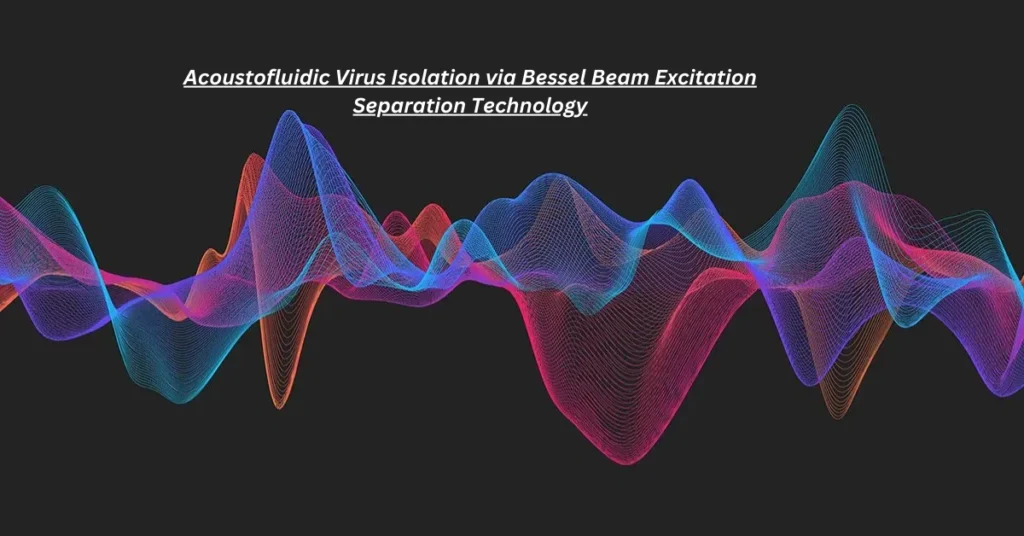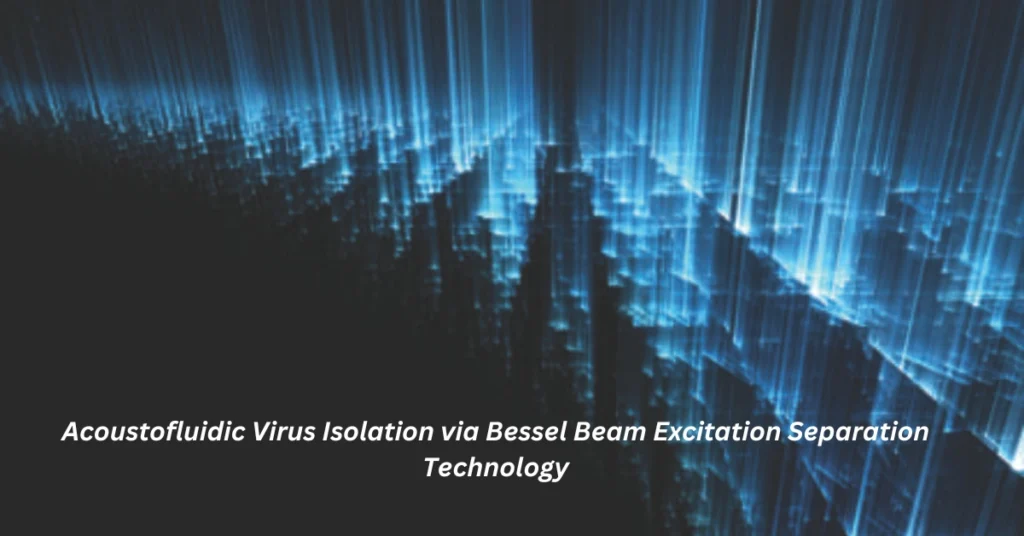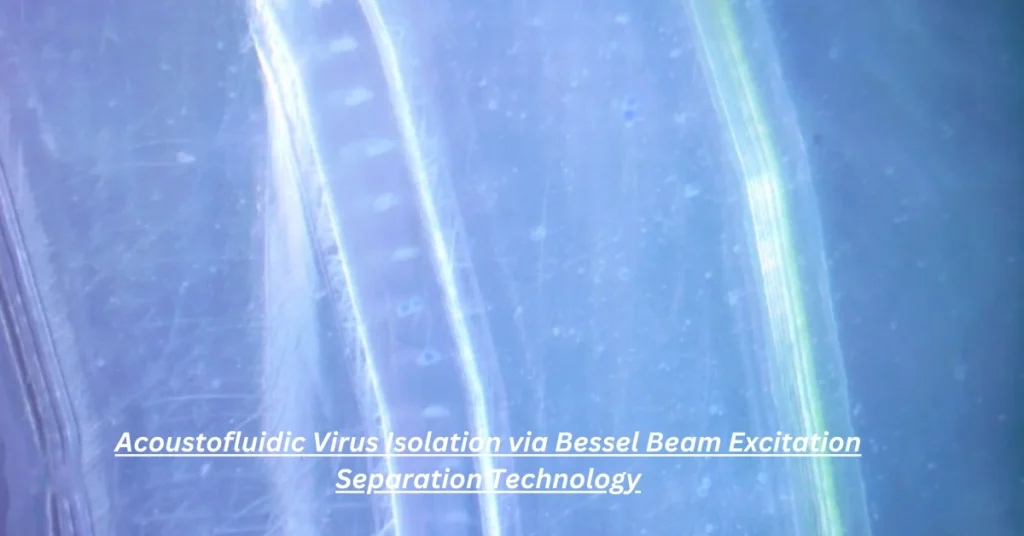Introduction
In the realm of virology, virus isolation is a crucial process, whether it’s for research, diagnostics, or vaccine development. Among the innovative methods making waves today, acoustofluidic virus isolation via Bessel beam excitation separation technology stands out for its precision and non-invasive nature. This cutting-edge technology uses sound waves to isolate viruses with high efficiency, providing a better alternative to traditional methods.
In this article, we’ll explore how this technology works, its advantages, and its broad applications, making it an indispensable tool in modern virology and biomedical research.
What is Acoustofluidic Virus Isolation?

Acoustofluidics is the fusion of acoustics (sound waves) and fluid dynamics, applied to manipulate small particles and cells within a fluid medium. Acoustofluidic virus isolation via Bessel beam excitation separation technology involves using ultrasound to create focused sound waves that exert forces on particles—specifically viruses—allowing for their isolation without physical filtration or chemical alteration.
By combining Bessel beam excitation, which provides a unique, non-diffracting wave focus, this technology enhances the precision of virus isolation, allowing for better control over the process.
How Does Acoustofluidic Virus Isolation Work?
The process begins by introducing a viral sample into a microfluidic chamber. Once the sample is in place, acoustofluidic virus isolation via Bessel beam excitation separation technology uses ultrasonic waves to create acoustic radiation forces. These forces push viruses into specific regions of the chamber, allowing them to be separated from other particles or contaminants. The Bessel beam’s unique properties help focus these waves more precisely, ensuring that even the smallest viruses are isolated with high accuracy.
Key Features of Bessel Beams in Virus Isolation

Bessel beams are a type of sound wave with special properties:
- Non-diffracting: Unlike conventional sound waves, Bessel beams maintain their shape over long distances, which is crucial for high-precision isolation.
- Focus Control: The ability to focus the beam with high resolution allows for more accurate isolation of viruses, which may be difficult to separate with traditional methods.
- High Efficiency: Bessel beams can isolate a larger number of viruses in a shorter period, increasing throughput in research and diagnostic applications.
Advantages of Acoustofluidic Virus Isolation via Bessel Beam Excitation
1. Non-Invasive and Gentle Process
One of the standout benefits of acoustofluidic virus isolation via Bessel beam excitation separation technology is that it is non-invasive. Unlike methods that rely on harsh mechanical forces, such as centrifugation, this technique uses sound waves to manipulate the viruses gently, preserving their structure and integrity. This is particularly important in research and diagnostic settings where the virus’s genetic material must remain intact for further analysis.
2. Precision and Selectivity
Bessel beam excitation allows for the isolation of viruses with unmatched precision. The waves can be fine-tuned to target specific viruses based on their size, shape, and other physical properties. This ensures that only the viruses of interest are isolated, making this technology highly selective and efficient.
3. Higher Throughput
Since the Bessel beam is highly focused and precise, acoustofluidic virus isolation via Bessel beam excitation separation technology can process large volumes of samples quickly. This high throughput capability makes it ideal for large-scale applications in both clinical and research environments, where rapid virus isolation is often essential.
4. Reduced Risk of Contamination
Because the process doesn’t rely on physical contact or filtration, there’s a significantly reduced risk of contamination in the samples. This makes the technique ideal for isolating viruses from complex biological fluids, where contamination is a common challenge.
Applications of Acoustofluidic Virus Isolation via Bessel Beam Excitation Separation Technology

1. Viral Diagnostics
In the field of viral diagnostics, isolating viruses from patient samples is a critical first step. Whether it’s for diagnosing an infection or for monitoring virus levels during treatment, acoustofluidic virus isolation via Bessel beam excitation separation technology offers a rapid, accurate, and contamination-free method to isolate viruses for testing.
2. Vaccine Development
For vaccine research, isolating specific viral strains is essential for understanding their properties and behavior. Acoustofluidic virus isolation via Bessel beam excitation separation technology provides a reliable way to isolate viruses without damaging their structure, ensuring that researchers can study them in their most natural form.
3. Oncolytic Virotherapy
In oncolytic virotherapy, viruses are used to selectively target and destroy cancer cells. Acoustofluidic virus isolation via Bessel beam excitation separation technology can isolate therapeutic viruses with high precision, ensuring that only the most effective strains are used in treatment.
4. Basic Research
For researchers studying viruses, the ability to isolate them efficiently and without degradation is essential. This technology provides the means to isolate viruses for study, allowing scientists to explore viral mechanisms, genetics, and interactions in a controlled environment.
How Does It Compare to Traditional Methods?
Traditional virus isolation techniques, such as centrifugation and filtration, often require large volumes of sample material and can lead to sample contamination or damage. These methods may also lack the precision needed to isolate very small or low-abundance viruses.
Acoustofluidic virus isolation via Bessel beam excitation separation technology offers several advantages:
- Higher Precision: Unlike traditional methods, which can sometimes result in a broad separation, this technology targets viruses with high specificity.
- Faster Process: It accelerates virus isolation, reducing the time required for sample preparation and analysis.
- Non-Invasive: Traditional methods can be harsh on delicate viral particles. In contrast, this acoustofluidic approach preserves virus integrity.
Frequently Asked Questions (FAQ)
1. What types of viruses can be isolated using acoustofluidic technology?
Acoustofluidic virus isolation via Bessel beam excitation separation technology can isolate a variety of viruses, including coronaviruses, influenza, HIV, and many others. The technique is adaptable and can be used for isolating both large and small viruses, depending on their physical characteristics.
2. How does this technology benefit diagnostic labs?
This technology allows diagnostic labs to isolate viruses from complex biological samples with high precision and minimal risk of contamination. The process is faster and gentler than traditional methods, making it ideal for rapid, accurate virus detection.
3. Is the virus integrity maintained during isolation?
Yes, one of the key advantages of acoustofluidic virus isolation via Bessel beam excitation separation technology is that it is a non-invasive method. The virus remains intact, preserving its genetic material for further analysis or therapeutic use.
4. How does it compare to PCR-based virus detection?
While PCR (Polymerase Chain Reaction) is effective for detecting viral genetic material, acoustofluidic virus isolation via Bessel beam excitation separation technology focuses on the physical separation of viruses, making it an important pre-step before PCR analysis. The technology ensures that only the target virus is isolated, leading to more accurate results.
Conclusion
Acoustofluidic virus isolation via Bessel beam excitation separation technology is a revolutionary method that enhances the precision, speed, and efficiency of virus isolation. By combining the power of acoustics with advanced microfluidic techniques, this approach is transforming virology, making virus isolation faster, more accurate, and less invasive.
This technology’s ability to isolate viruses with high specificity while maintaining their integrity opens up exciting possibilities in diagnostics, research, vaccine development, and therapeutic applications. As the field of virology continues to evolve, acoustofluidic virus isolation via Bessel beam excitation separation technology will undoubtedly play a crucial role in advancing our understanding and treatment of viral diseases.
Discover the ultimate Definitive Technology BP7002 Amplifier Repair Kit for sale and bring your sound system back to life with ease.
